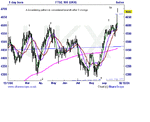barjon said:
paul
good example.
mmm, in general I see it slightly differently if you start from two facts: 1. For every sale there must be a buy - thus buys and sells are always equal and there can't be a preponderance on one side or the other. 2. You can only sell at a price if someone wants to buy at that price (forgetting spread) and vice versa.
There can, of course, be a preponderance of buyers or sellers waiting in the wings, either because of new participants arriving on one side or because of numbers on one side reducing (or because the price isn't yet right). By the time a volume bar prints it's history and we're only interested in it to give us clues about who's waiting in the wings.
So, in your down trend, sellers continually need to offer down to attract buyers and it's maybe a clue that more sellers than buyers wait in the wings. When there is large volume, more of those sellers are able to offload because more willing buyers have arrived and that's maybe a clue that there may soon be more buyers than sellers in the wings.
Does that sound logical? I wonder if it's right 😆
jon
Jon
I have attached an example trading scenario to explain the volume question from yesterday.
I hope the spreadsheet is comprehensible but I will try to run through it and explain it here.
Firstly we have Bank A with chief trade Jon, on the other side of the road we have Bank B, with chief trader Paul. One day Jon’s director comes in and says ‘Jon I want you guys to get off your hands and make some money take a look at that XYZ stock”. Jon has ten traders working for him. At the same time the director of bank B comes and says to Paul ‘Trade that XYZ stock till it bleeds”… or what ever they usually say
Jon does his analysis and he consults with his traders, they agree the market should be sold. Bank A owns 100 shares
Paul does his analysis and he agrees with his traders the market should be bought. Bank B does not own any XYZ shares but are authorized to enter the market and buy 100.
Frank Market Maker just wants to make some money today. He makes a market in XYZ stock and has an inventory of 300 shares on his book.
The market opens.
1. Jon and his traders decide to sell the market in XYZ, trader 1 sells 5 shares – see line one of xls. Bank B thinks that the shares are still too expensive and they buy just 1. Frank sees his inventory rise, he needs to get rid of some shares so he drops the price to encourage some buyers
2. Bank A sell 7 , bank B buys 5, Frank gets even more stock so lowers the price again.
3. Bank A sells 15 and is starting to get quite aggressive, Bank B think ‘This is more like it’ and buy 10. Frank now has way too much stock, he must hold as close to 300 as possible, he holds early 4% more than this and lowers the price yet again in order to get some buyers in.
4. Bank A really wants to off load now and lock in that profit, they sell 15 again. Bank B buys 10 again.
5. And so on.
6. When trader 6 for bank A and trader 6 for Bank B come into the market, Bank A sell s20 and Bank B buys 20. Frank’s stock holds steady at 316 but he needs to get it down. So he lowers price yet again
7. Bank B se the price now at 43 and they come in strong they buy 20, and Bank A sell just 10.
8. Buyers now have control, Bank A have just a few shares left to sell, they off load 10, BANK B get the whiff of rising prices they come in aggressively and buy 13. Franks book is beginning to balance he starts to raise prices in case the book becomes short
9. And so on.
10. Book balanced, seller sold out buyers bought in.
The one thing I haven’t mentioned is the volume, which is where we started, look at column M , you will see it increases and the decreases again. When trader 6 comes in aggressively from both banks it hits 40. So the volume has gradually increased whilst the control is passed from the seller to the buyer.
That’s the way I see it, I hope the above is of some use and interest.
Best Regards
Paul (goshort) (Bank B!)

